BTEC HND Business and Business Environment Report - UK College
VerifiedAdded on 2020/12/18
|20
|5096
|123
Report
AI Summary
This report provides a comprehensive overview of the business environment, focusing on private, public, and voluntary sectors. It begins with an introduction to the business environment, defining its impact on business operations, profitability, and survival. The report then delves into the different types and purposes of organizations, including private, public, and voluntary sectors, with examples such as Marks & Spencer, British Petroleum (BP), and the Wellcome Trust. It explores the advantages and disadvantages of each sector, as well as the differences between profit, non-profit, and non-governmental organizations. The report also examines the size and scope of different types of companies, from micro to large enterprises, and highlights the key differences between them. It includes organizational structures of Marks and Spencer, BP, and the Wellcome Trust and concludes with a summary of the key findings and references used in the report. This report is a valuable resource for students studying business and the business environment.
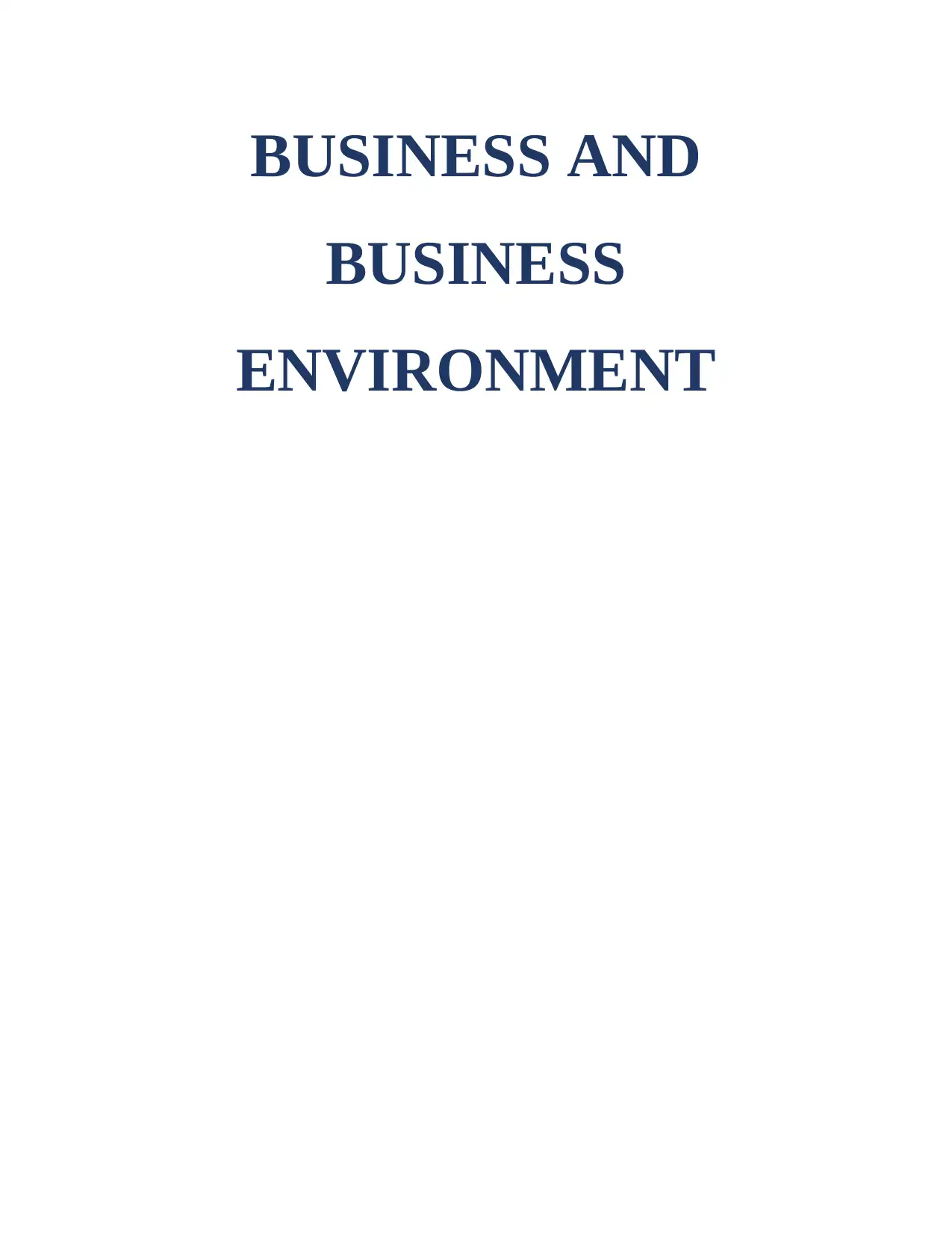
BUSINESS AND
BUSINESS
ENVIRONMENT
BUSINESS
ENVIRONMENT
Paraphrase This Document
Need a fresh take? Get an instant paraphrase of this document with our AI Paraphraser
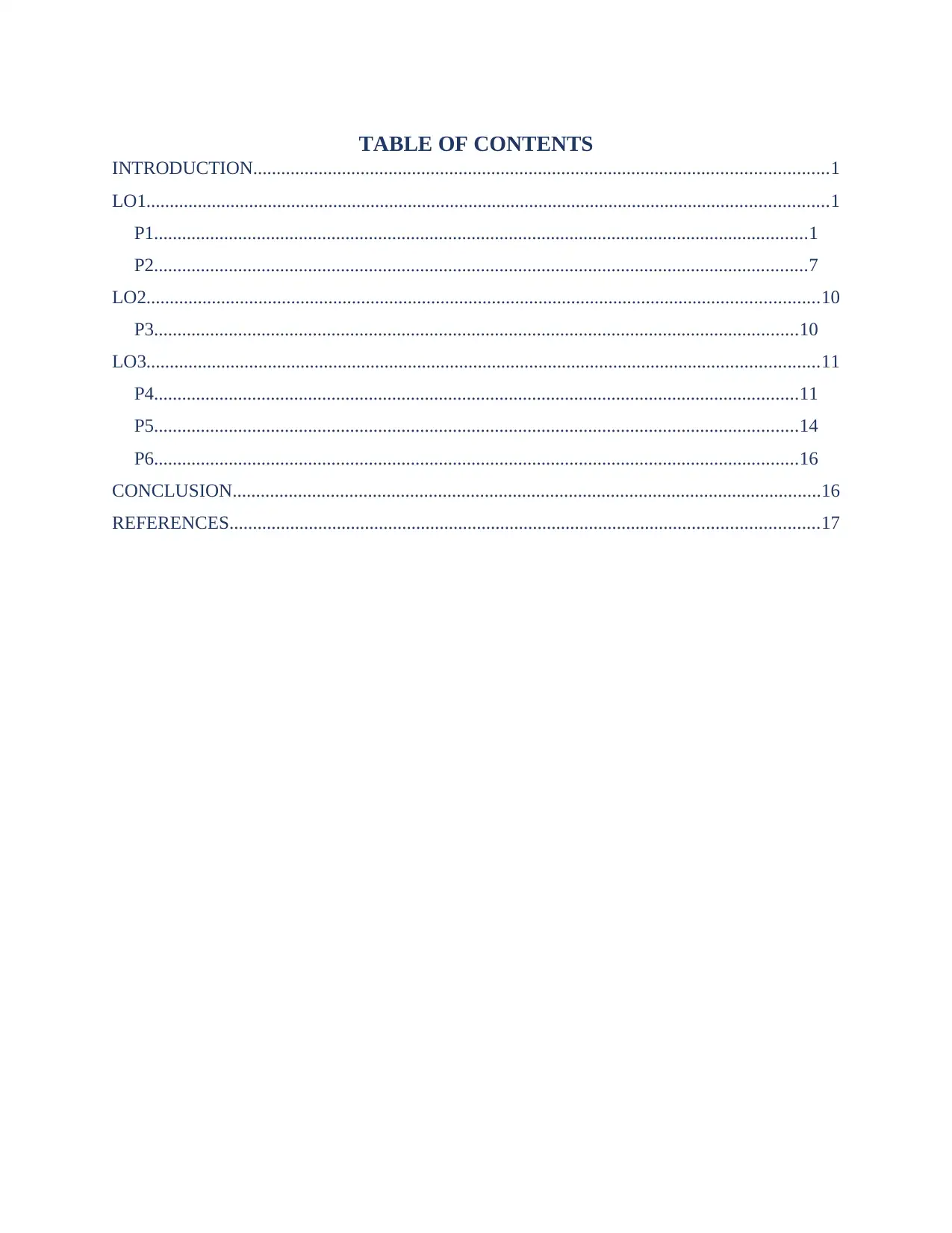
TABLE OF CONTENTS
INTRODUCTION...........................................................................................................................1
LO1..................................................................................................................................................1
P1............................................................................................................................................1
P2............................................................................................................................................7
LO2................................................................................................................................................10
P3..........................................................................................................................................10
LO3................................................................................................................................................11
P4..........................................................................................................................................11
P5..........................................................................................................................................14
P6..........................................................................................................................................16
CONCLUSION..............................................................................................................................16
REFERENCES..............................................................................................................................17
INTRODUCTION...........................................................................................................................1
LO1..................................................................................................................................................1
P1............................................................................................................................................1
P2............................................................................................................................................7
LO2................................................................................................................................................10
P3..........................................................................................................................................10
LO3................................................................................................................................................11
P4..........................................................................................................................................11
P5..........................................................................................................................................14
P6..........................................................................................................................................16
CONCLUSION..............................................................................................................................16
REFERENCES..............................................................................................................................17
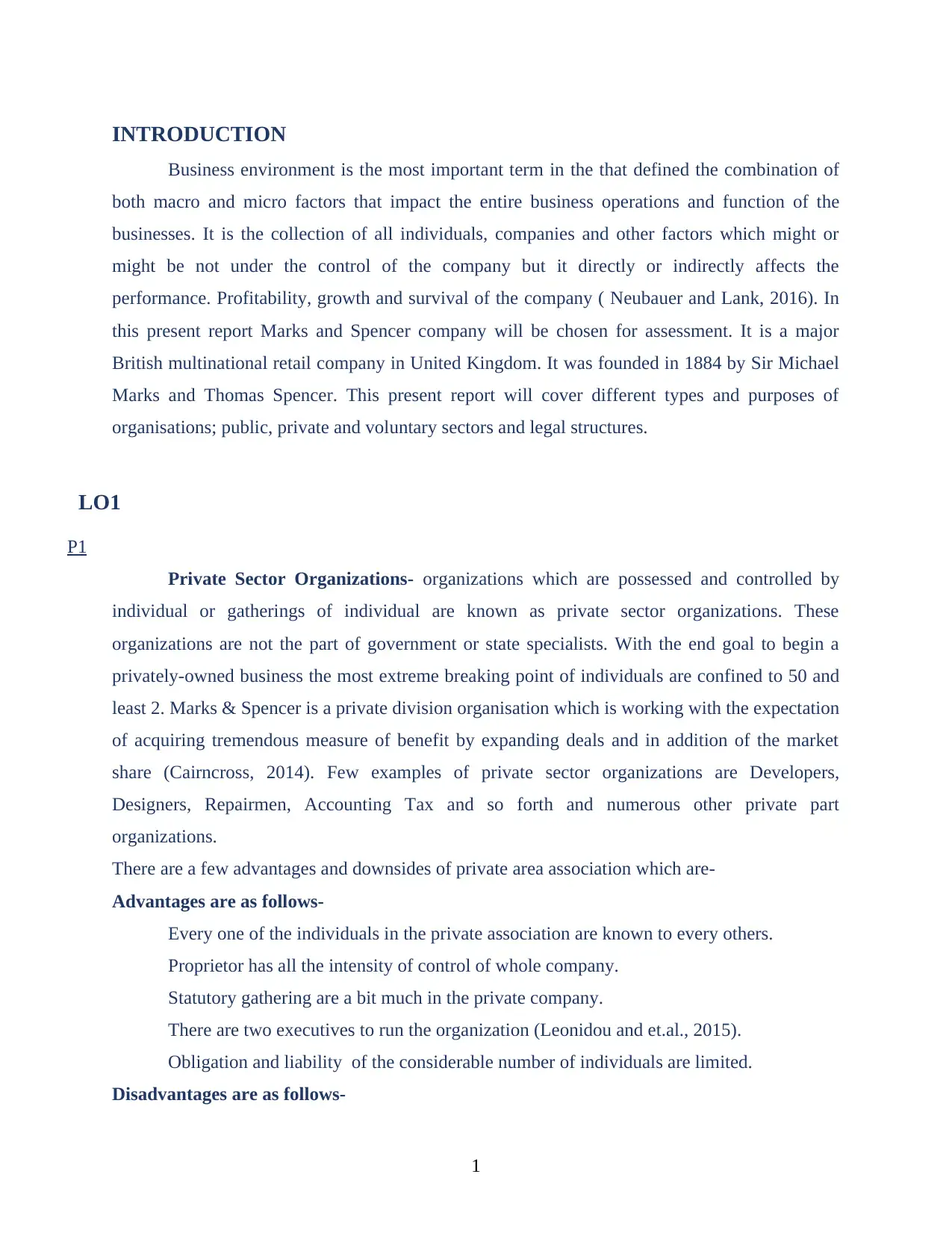
INTRODUCTION
Business environment is the most important term in the that defined the combination of
both macro and micro factors that impact the entire business operations and function of the
businesses. It is the collection of all individuals, companies and other factors which might or
might be not under the control of the company but it directly or indirectly affects the
performance. Profitability, growth and survival of the company ( Neubauer and Lank, 2016). In
this present report Marks and Spencer company will be chosen for assessment. It is a major
British multinational retail company in United Kingdom. It was founded in 1884 by Sir Michael
Marks and Thomas Spencer. This present report will cover different types and purposes of
organisations; public, private and voluntary sectors and legal structures.
LO1
P1
Private Sector Organizations- organizations which are possessed and controlled by
individual or gatherings of individual are known as private sector organizations. These
organizations are not the part of government or state specialists. With the end goal to begin a
privately-owned business the most extreme breaking point of individuals are confined to 50 and
least 2. Marks & Spencer is a private division organisation which is working with the expectation
of acquiring tremendous measure of benefit by expanding deals and in addition of the market
share (Cairncross, 2014). Few examples of private sector organizations are Developers,
Designers, Repairmen, Accounting Tax and so forth and numerous other private part
organizations.
There are a few advantages and downsides of private area association which are-
Advantages are as follows-
Every one of the individuals in the private association are known to every others.
Proprietor has all the intensity of control of whole company.
Statutory gathering are a bit much in the private company.
There are two executives to run the organization (Leonidou and et.al., 2015).
Obligation and liability of the considerable number of individuals are limited.
Disadvantages are as follows-
1
Business environment is the most important term in the that defined the combination of
both macro and micro factors that impact the entire business operations and function of the
businesses. It is the collection of all individuals, companies and other factors which might or
might be not under the control of the company but it directly or indirectly affects the
performance. Profitability, growth and survival of the company ( Neubauer and Lank, 2016). In
this present report Marks and Spencer company will be chosen for assessment. It is a major
British multinational retail company in United Kingdom. It was founded in 1884 by Sir Michael
Marks and Thomas Spencer. This present report will cover different types and purposes of
organisations; public, private and voluntary sectors and legal structures.
LO1
P1
Private Sector Organizations- organizations which are possessed and controlled by
individual or gatherings of individual are known as private sector organizations. These
organizations are not the part of government or state specialists. With the end goal to begin a
privately-owned business the most extreme breaking point of individuals are confined to 50 and
least 2. Marks & Spencer is a private division organisation which is working with the expectation
of acquiring tremendous measure of benefit by expanding deals and in addition of the market
share (Cairncross, 2014). Few examples of private sector organizations are Developers,
Designers, Repairmen, Accounting Tax and so forth and numerous other private part
organizations.
There are a few advantages and downsides of private area association which are-
Advantages are as follows-
Every one of the individuals in the private association are known to every others.
Proprietor has all the intensity of control of whole company.
Statutory gathering are a bit much in the private company.
There are two executives to run the organization (Leonidou and et.al., 2015).
Obligation and liability of the considerable number of individuals are limited.
Disadvantages are as follows-
1
⊘ This is a preview!⊘
Do you want full access?
Subscribe today to unlock all pages.

Trusted by 1+ million students worldwide
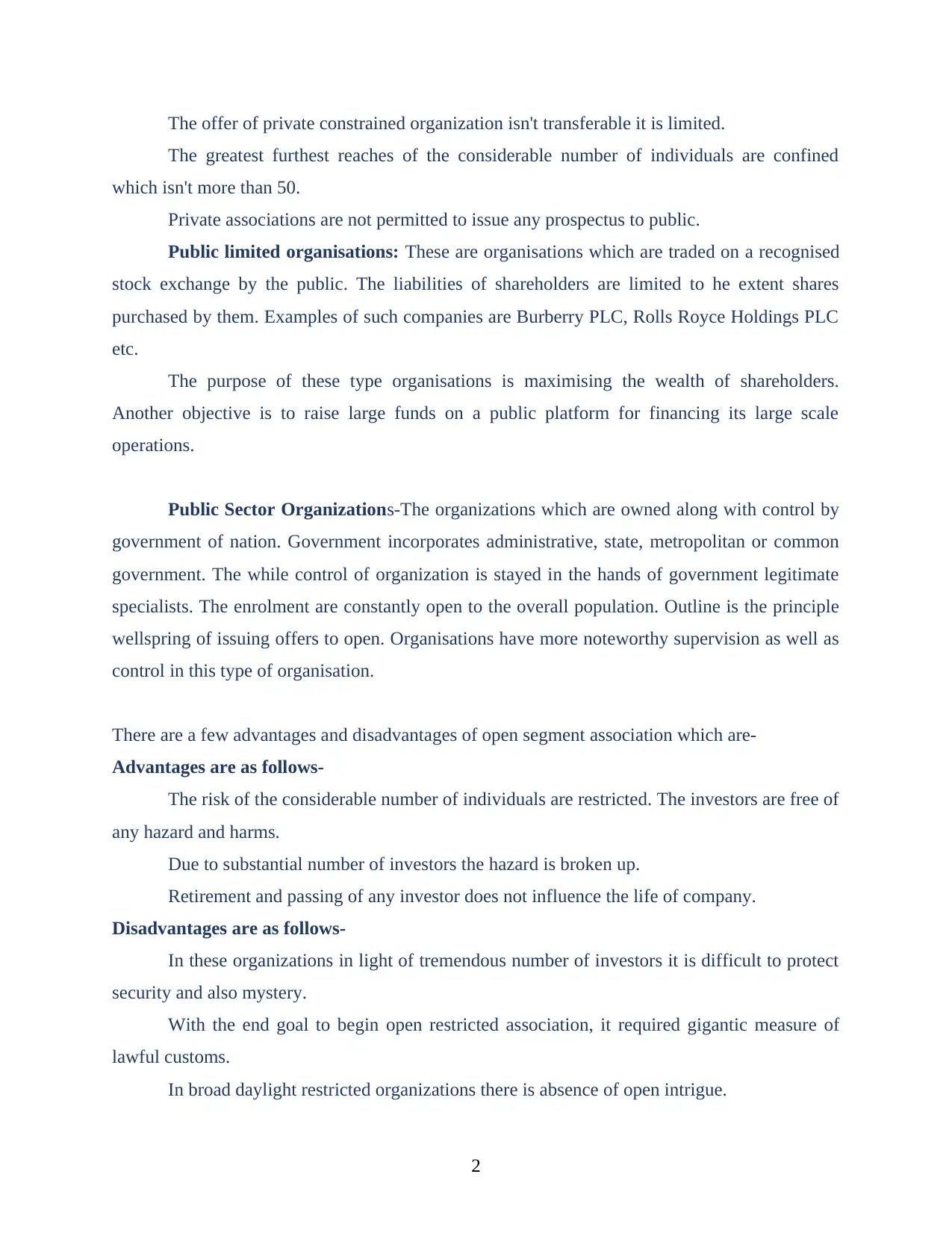
The offer of private constrained organization isn't transferable it is limited.
The greatest furthest reaches of the considerable number of individuals are confined
which isn't more than 50.
Private associations are not permitted to issue any prospectus to public.
Public limited organisations: These are organisations which are traded on a recognised
stock exchange by the public. The liabilities of shareholders are limited to he extent shares
purchased by them. Examples of such companies are Burberry PLC, Rolls Royce Holdings PLC
etc.
The purpose of these type organisations is maximising the wealth of shareholders.
Another objective is to raise large funds on a public platform for financing its large scale
operations.
Public Sector Organizations-The organizations which are owned along with control by
government of nation. Government incorporates administrative, state, metropolitan or common
government. The while control of organization is stayed in the hands of government legitimate
specialists. The enrolment are constantly open to the overall population. Outline is the principle
wellspring of issuing offers to open. Organisations have more noteworthy supervision as well as
control in this type of organisation.
There are a few advantages and disadvantages of open segment association which are-
Advantages are as follows-
The risk of the considerable number of individuals are restricted. The investors are free of
any hazard and harms.
Due to substantial number of investors the hazard is broken up.
Retirement and passing of any investor does not influence the life of company.
Disadvantages are as follows-
In these organizations in light of tremendous number of investors it is difficult to protect
security and also mystery.
With the end goal to begin open restricted association, it required gigantic measure of
lawful customs.
In broad daylight restricted organizations there is absence of open intrigue.
2
The greatest furthest reaches of the considerable number of individuals are confined
which isn't more than 50.
Private associations are not permitted to issue any prospectus to public.
Public limited organisations: These are organisations which are traded on a recognised
stock exchange by the public. The liabilities of shareholders are limited to he extent shares
purchased by them. Examples of such companies are Burberry PLC, Rolls Royce Holdings PLC
etc.
The purpose of these type organisations is maximising the wealth of shareholders.
Another objective is to raise large funds on a public platform for financing its large scale
operations.
Public Sector Organizations-The organizations which are owned along with control by
government of nation. Government incorporates administrative, state, metropolitan or common
government. The while control of organization is stayed in the hands of government legitimate
specialists. The enrolment are constantly open to the overall population. Outline is the principle
wellspring of issuing offers to open. Organisations have more noteworthy supervision as well as
control in this type of organisation.
There are a few advantages and disadvantages of open segment association which are-
Advantages are as follows-
The risk of the considerable number of individuals are restricted. The investors are free of
any hazard and harms.
Due to substantial number of investors the hazard is broken up.
Retirement and passing of any investor does not influence the life of company.
Disadvantages are as follows-
In these organizations in light of tremendous number of investors it is difficult to protect
security and also mystery.
With the end goal to begin open restricted association, it required gigantic measure of
lawful customs.
In broad daylight restricted organizations there is absence of open intrigue.
2
Paraphrase This Document
Need a fresh take? Get an instant paraphrase of this document with our AI Paraphraser
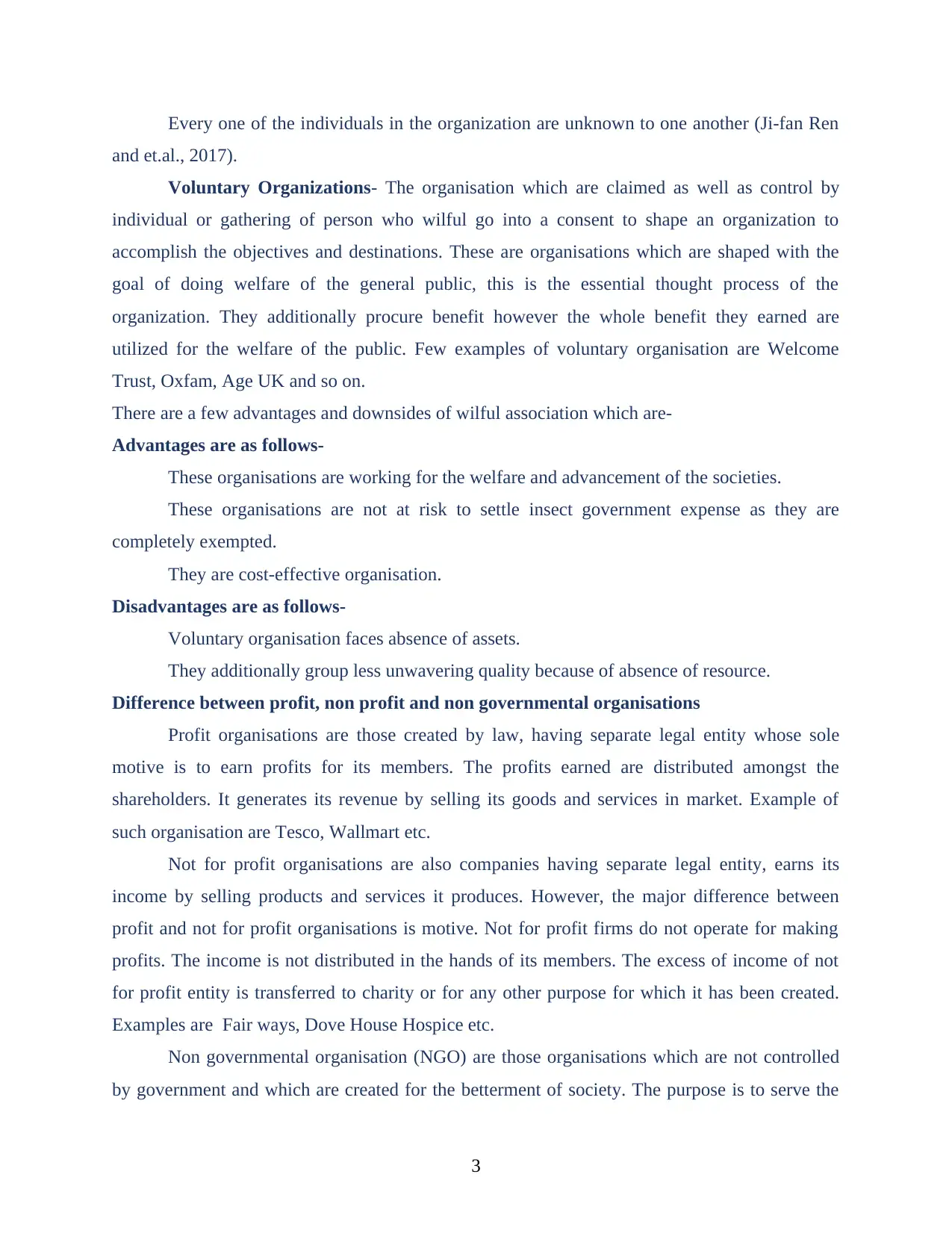
Every one of the individuals in the organization are unknown to one another (Ji-fan Ren
and et.al., 2017).
Voluntary Organizations- The organisation which are claimed as well as control by
individual or gathering of person who wilful go into a consent to shape an organization to
accomplish the objectives and destinations. These are organisations which are shaped with the
goal of doing welfare of the general public, this is the essential thought process of the
organization. They additionally procure benefit however the whole benefit they earned are
utilized for the welfare of the public. Few examples of voluntary organisation are Welcome
Trust, Oxfam, Age UK and so on.
There are a few advantages and downsides of wilful association which are-
Advantages are as follows-
These organisations are working for the welfare and advancement of the societies.
These organisations are not at risk to settle insect government expense as they are
completely exempted.
They are cost-effective organisation.
Disadvantages are as follows-
Voluntary organisation faces absence of assets.
They additionally group less unwavering quality because of absence of resource.
Difference between profit, non profit and non governmental organisations
Profit organisations are those created by law, having separate legal entity whose sole
motive is to earn profits for its members. The profits earned are distributed amongst the
shareholders. It generates its revenue by selling its goods and services in market. Example of
such organisation are Tesco, Wallmart etc.
Not for profit organisations are also companies having separate legal entity, earns its
income by selling products and services it produces. However, the major difference between
profit and not for profit organisations is motive. Not for profit firms do not operate for making
profits. The income is not distributed in the hands of its members. The excess of income of not
for profit entity is transferred to charity or for any other purpose for which it has been created.
Examples are Fair ways, Dove House Hospice etc.
Non governmental organisation (NGO) are those organisations which are not controlled
by government and which are created for the betterment of society. The purpose is to serve the
3
and et.al., 2017).
Voluntary Organizations- The organisation which are claimed as well as control by
individual or gathering of person who wilful go into a consent to shape an organization to
accomplish the objectives and destinations. These are organisations which are shaped with the
goal of doing welfare of the general public, this is the essential thought process of the
organization. They additionally procure benefit however the whole benefit they earned are
utilized for the welfare of the public. Few examples of voluntary organisation are Welcome
Trust, Oxfam, Age UK and so on.
There are a few advantages and downsides of wilful association which are-
Advantages are as follows-
These organisations are working for the welfare and advancement of the societies.
These organisations are not at risk to settle insect government expense as they are
completely exempted.
They are cost-effective organisation.
Disadvantages are as follows-
Voluntary organisation faces absence of assets.
They additionally group less unwavering quality because of absence of resource.
Difference between profit, non profit and non governmental organisations
Profit organisations are those created by law, having separate legal entity whose sole
motive is to earn profits for its members. The profits earned are distributed amongst the
shareholders. It generates its revenue by selling its goods and services in market. Example of
such organisation are Tesco, Wallmart etc.
Not for profit organisations are also companies having separate legal entity, earns its
income by selling products and services it produces. However, the major difference between
profit and not for profit organisations is motive. Not for profit firms do not operate for making
profits. The income is not distributed in the hands of its members. The excess of income of not
for profit entity is transferred to charity or for any other purpose for which it has been created.
Examples are Fair ways, Dove House Hospice etc.
Non governmental organisation (NGO) are those organisations which are not controlled
by government and which are created for the betterment of society. The purpose is to serve the
3
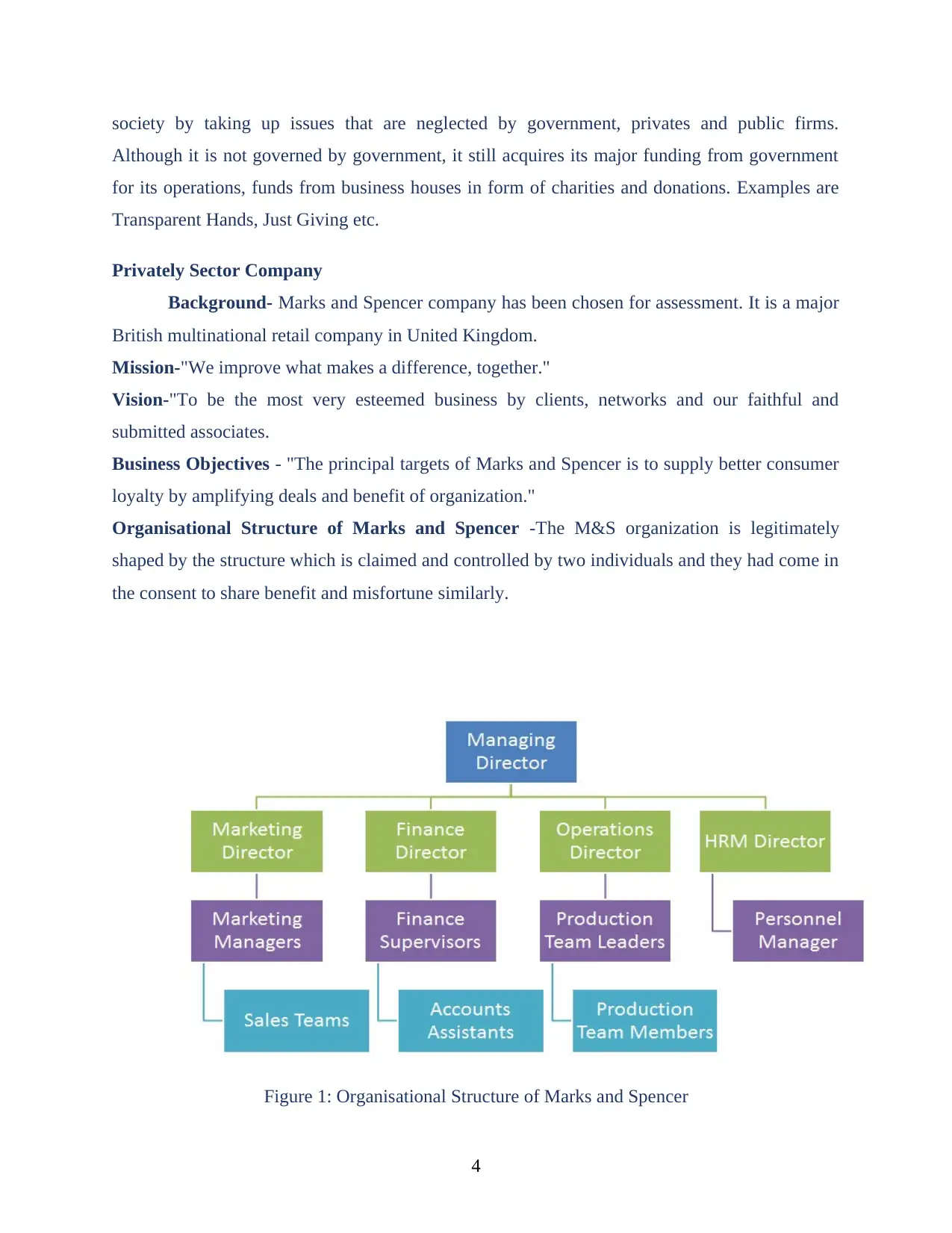
society by taking up issues that are neglected by government, privates and public firms.
Although it is not governed by government, it still acquires its major funding from government
for its operations, funds from business houses in form of charities and donations. Examples are
Transparent Hands, Just Giving etc.
Privately Sector Company
Background- Marks and Spencer company has been chosen for assessment. It is a major
British multinational retail company in United Kingdom.
Mission-"We improve what makes a difference, together."
Vision-"To be the most very esteemed business by clients, networks and our faithful and
submitted associates.
Business Objectives - "The principal targets of Marks and Spencer is to supply better consumer
loyalty by amplifying deals and benefit of organization."
Organisational Structure of Marks and Spencer -The M&S organization is legitimately
shaped by the structure which is claimed and controlled by two individuals and they had come in
the consent to share benefit and misfortune similarly.
Figure 1: Organisational Structure of Marks and Spencer
4
Although it is not governed by government, it still acquires its major funding from government
for its operations, funds from business houses in form of charities and donations. Examples are
Transparent Hands, Just Giving etc.
Privately Sector Company
Background- Marks and Spencer company has been chosen for assessment. It is a major
British multinational retail company in United Kingdom.
Mission-"We improve what makes a difference, together."
Vision-"To be the most very esteemed business by clients, networks and our faithful and
submitted associates.
Business Objectives - "The principal targets of Marks and Spencer is to supply better consumer
loyalty by amplifying deals and benefit of organization."
Organisational Structure of Marks and Spencer -The M&S organization is legitimately
shaped by the structure which is claimed and controlled by two individuals and they had come in
the consent to share benefit and misfortune similarly.
Figure 1: Organisational Structure of Marks and Spencer
4
⊘ This is a preview!⊘
Do you want full access?
Subscribe today to unlock all pages.

Trusted by 1+ million students worldwide
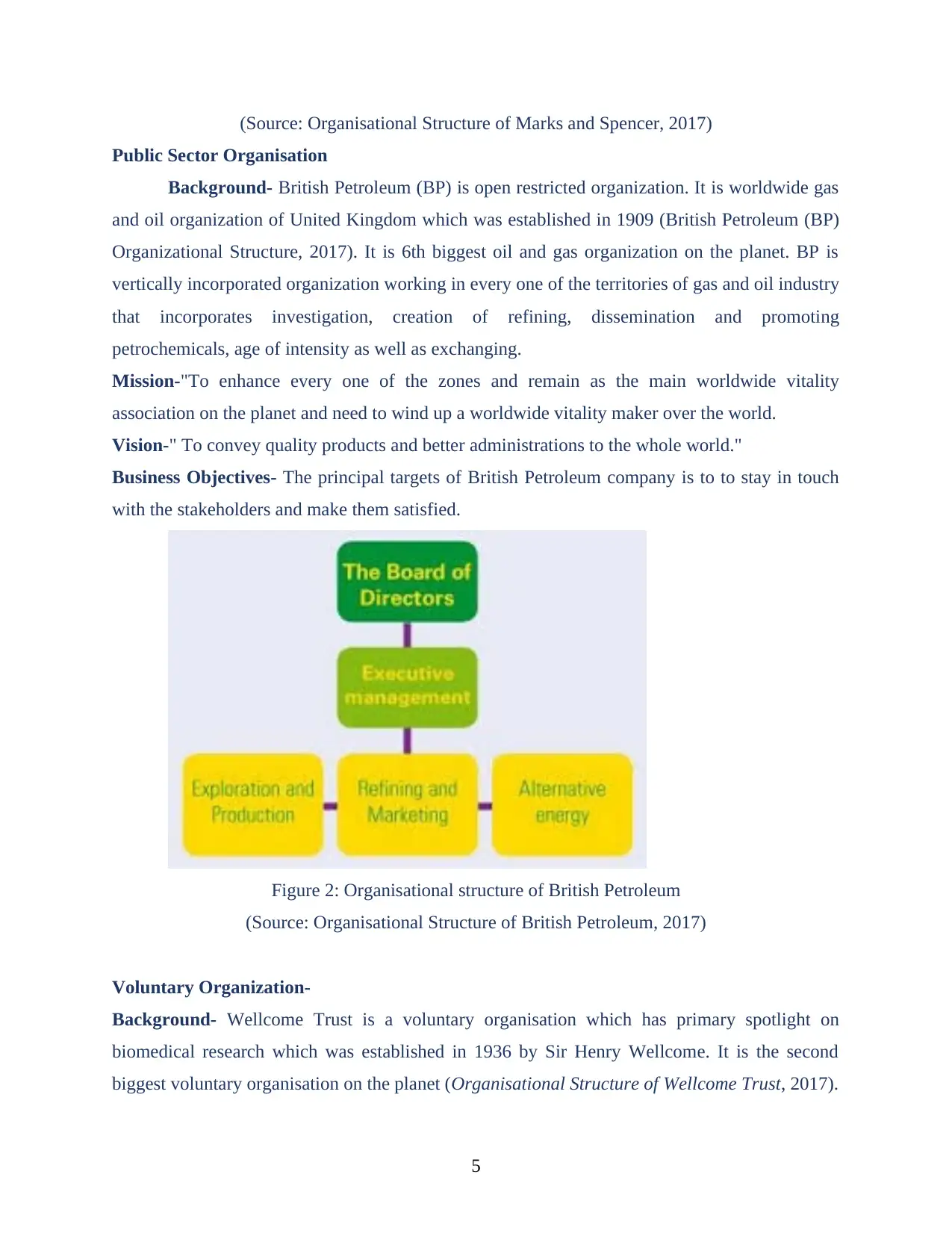
(Source: Organisational Structure of Marks and Spencer, 2017)
Public Sector Organisation
Background- British Petroleum (BP) is open restricted organization. It is worldwide gas
and oil organization of United Kingdom which was established in 1909 (British Petroleum (BP)
Organizational Structure, 2017). It is 6th biggest oil and gas organization on the planet. BP is
vertically incorporated organization working in every one of the territories of gas and oil industry
that incorporates investigation, creation of refining, dissemination and promoting
petrochemicals, age of intensity as well as exchanging.
Mission-"To enhance every one of the zones and remain as the main worldwide vitality
association on the planet and need to wind up a worldwide vitality maker over the world.
Vision-" To convey quality products and better administrations to the whole world."
Business Objectives- The principal targets of British Petroleum company is to to stay in touch
with the stakeholders and make them satisfied.
Figure 2: Organisational structure of British Petroleum
(Source: Organisational Structure of British Petroleum, 2017)
Voluntary Organization-
Background- Wellcome Trust is a voluntary organisation which has primary spotlight on
biomedical research which was established in 1936 by Sir Henry Wellcome. It is the second
biggest voluntary organisation on the planet (Organisational Structure of Wellcome Trust, 2017).
5
Public Sector Organisation
Background- British Petroleum (BP) is open restricted organization. It is worldwide gas
and oil organization of United Kingdom which was established in 1909 (British Petroleum (BP)
Organizational Structure, 2017). It is 6th biggest oil and gas organization on the planet. BP is
vertically incorporated organization working in every one of the territories of gas and oil industry
that incorporates investigation, creation of refining, dissemination and promoting
petrochemicals, age of intensity as well as exchanging.
Mission-"To enhance every one of the zones and remain as the main worldwide vitality
association on the planet and need to wind up a worldwide vitality maker over the world.
Vision-" To convey quality products and better administrations to the whole world."
Business Objectives- The principal targets of British Petroleum company is to to stay in touch
with the stakeholders and make them satisfied.
Figure 2: Organisational structure of British Petroleum
(Source: Organisational Structure of British Petroleum, 2017)
Voluntary Organization-
Background- Wellcome Trust is a voluntary organisation which has primary spotlight on
biomedical research which was established in 1936 by Sir Henry Wellcome. It is the second
biggest voluntary organisation on the planet (Organisational Structure of Wellcome Trust, 2017).
5
Paraphrase This Document
Need a fresh take? Get an instant paraphrase of this document with our AI Paraphraser
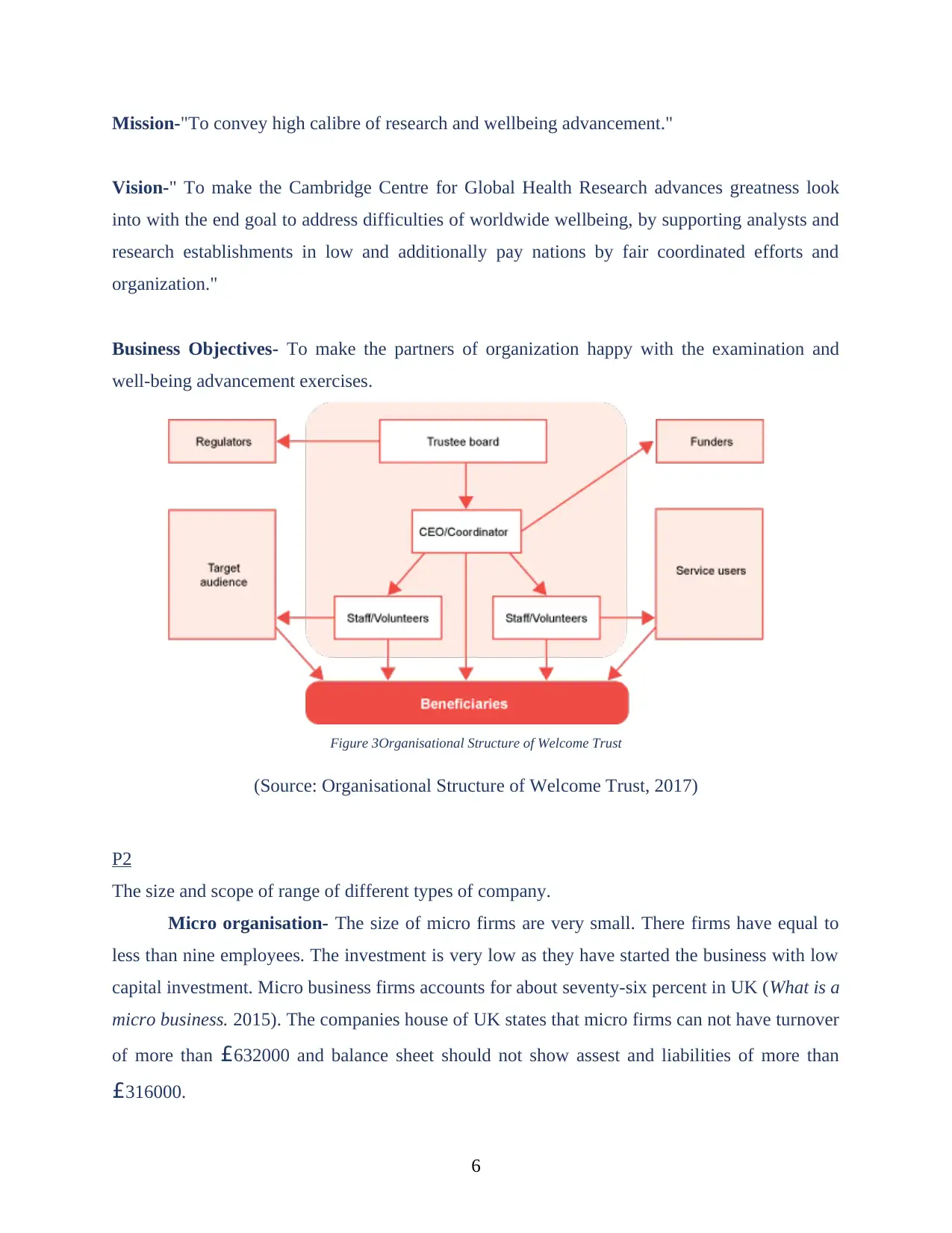
Mission-"To convey high calibre of research and wellbeing advancement."
Vision-" To make the Cambridge Centre for Global Health Research advances greatness look
into with the end goal to address difficulties of worldwide wellbeing, by supporting analysts and
research establishments in low and additionally pay nations by fair coordinated efforts and
organization."
Business Objectives- To make the partners of organization happy with the examination and
well-being advancement exercises.
Figure 3Organisational Structure of Welcome Trust
(Source: Organisational Structure of Welcome Trust, 2017)
P2
The size and scope of range of different types of company.
Micro organisation- The size of micro firms are very small. There firms have equal to
less than nine employees. The investment is very low as they have started the business with low
capital investment. Micro business firms accounts for about seventy-six percent in UK (What is a
micro business. 2015). The companies house of UK states that micro firms can not have turnover
of more than £632000 and balance sheet should not show assest and liabilities of more than
£316000.
6
Vision-" To make the Cambridge Centre for Global Health Research advances greatness look
into with the end goal to address difficulties of worldwide wellbeing, by supporting analysts and
research establishments in low and additionally pay nations by fair coordinated efforts and
organization."
Business Objectives- To make the partners of organization happy with the examination and
well-being advancement exercises.
Figure 3Organisational Structure of Welcome Trust
(Source: Organisational Structure of Welcome Trust, 2017)
P2
The size and scope of range of different types of company.
Micro organisation- The size of micro firms are very small. There firms have equal to
less than nine employees. The investment is very low as they have started the business with low
capital investment. Micro business firms accounts for about seventy-six percent in UK (What is a
micro business. 2015). The companies house of UK states that micro firms can not have turnover
of more than £632000 and balance sheet should not show assest and liabilities of more than
£316000.
6
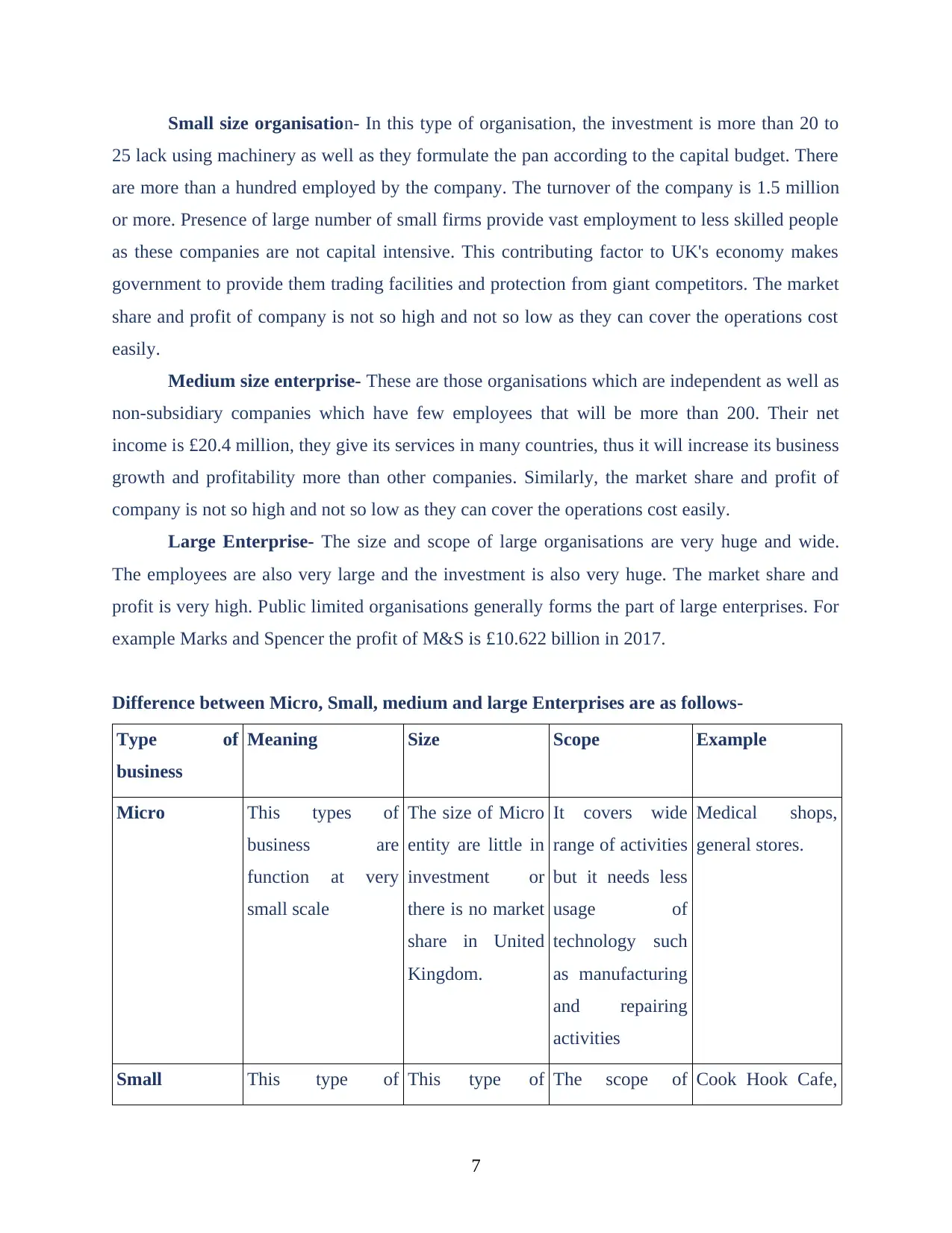
Small size organisation- In this type of organisation, the investment is more than 20 to
25 lack using machinery as well as they formulate the pan according to the capital budget. There
are more than a hundred employed by the company. The turnover of the company is 1.5 million
or more. Presence of large number of small firms provide vast employment to less skilled people
as these companies are not capital intensive. This contributing factor to UK's economy makes
government to provide them trading facilities and protection from giant competitors. The market
share and profit of company is not so high and not so low as they can cover the operations cost
easily.
Medium size enterprise- These are those organisations which are independent as well as
non-subsidiary companies which have few employees that will be more than 200. Their net
income is £20.4 million, they give its services in many countries, thus it will increase its business
growth and profitability more than other companies. Similarly, the market share and profit of
company is not so high and not so low as they can cover the operations cost easily.
Large Enterprise- The size and scope of large organisations are very huge and wide.
The employees are also very large and the investment is also very huge. The market share and
profit is very high. Public limited organisations generally forms the part of large enterprises. For
example Marks and Spencer the profit of M&S is £10.622 billion in 2017.
Difference between Micro, Small, medium and large Enterprises are as follows-
Type of
business
Meaning Size Scope Example
Micro This types of
business are
function at very
small scale
The size of Micro
entity are little in
investment or
there is no market
share in United
Kingdom.
It covers wide
range of activities
but it needs less
usage of
technology such
as manufacturing
and repairing
activities
Medical shops,
general stores.
Small This type of This type of The scope of Cook Hook Cafe,
7
25 lack using machinery as well as they formulate the pan according to the capital budget. There
are more than a hundred employed by the company. The turnover of the company is 1.5 million
or more. Presence of large number of small firms provide vast employment to less skilled people
as these companies are not capital intensive. This contributing factor to UK's economy makes
government to provide them trading facilities and protection from giant competitors. The market
share and profit of company is not so high and not so low as they can cover the operations cost
easily.
Medium size enterprise- These are those organisations which are independent as well as
non-subsidiary companies which have few employees that will be more than 200. Their net
income is £20.4 million, they give its services in many countries, thus it will increase its business
growth and profitability more than other companies. Similarly, the market share and profit of
company is not so high and not so low as they can cover the operations cost easily.
Large Enterprise- The size and scope of large organisations are very huge and wide.
The employees are also very large and the investment is also very huge. The market share and
profit is very high. Public limited organisations generally forms the part of large enterprises. For
example Marks and Spencer the profit of M&S is £10.622 billion in 2017.
Difference between Micro, Small, medium and large Enterprises are as follows-
Type of
business
Meaning Size Scope Example
Micro This types of
business are
function at very
small scale
The size of Micro
entity are little in
investment or
there is no market
share in United
Kingdom.
It covers wide
range of activities
but it needs less
usage of
technology such
as manufacturing
and repairing
activities
Medical shops,
general stores.
Small This type of This type of The scope of Cook Hook Cafe,
7
⊘ This is a preview!⊘
Do you want full access?
Subscribe today to unlock all pages.

Trusted by 1+ million students worldwide
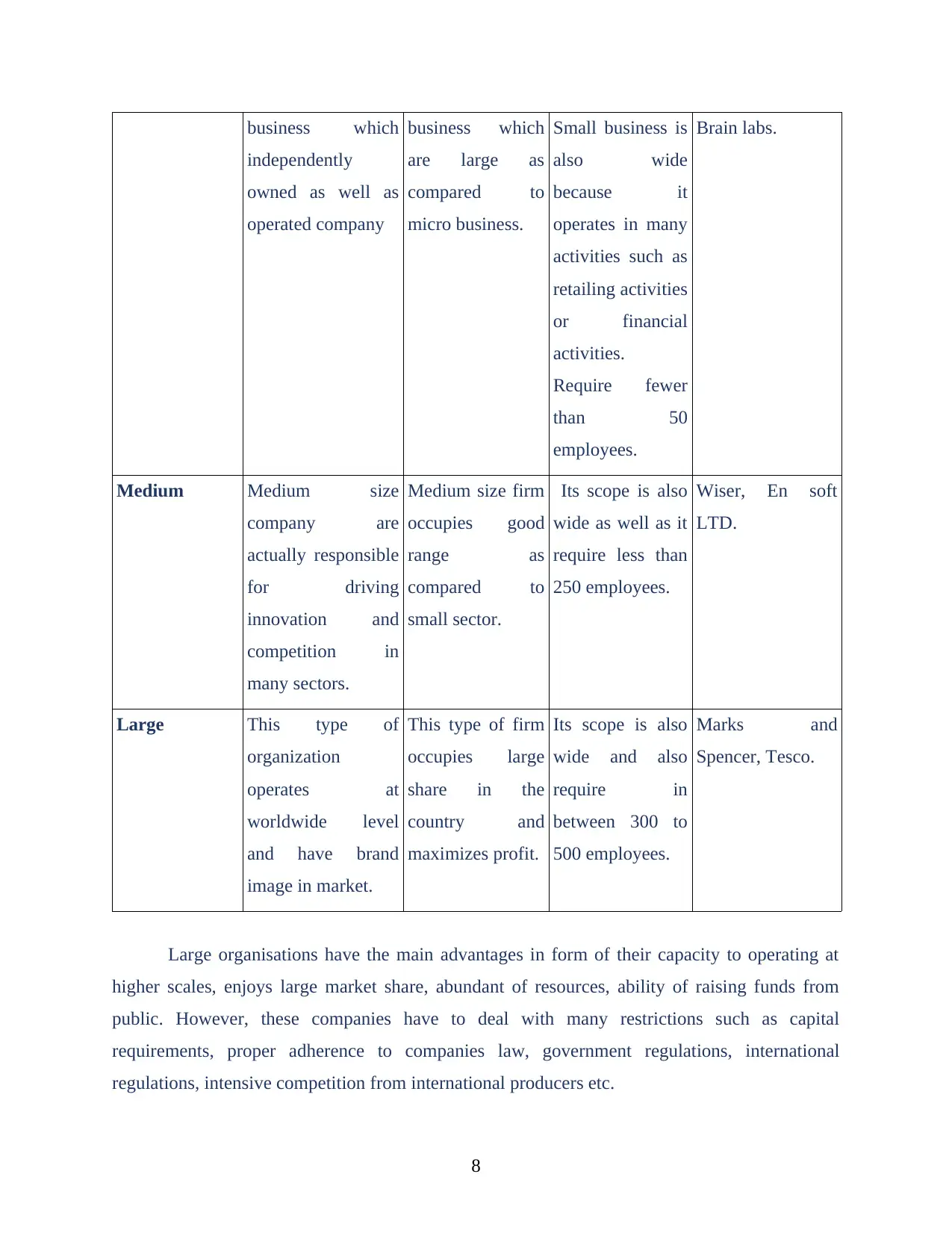
business which
independently
owned as well as
operated company
business which
are large as
compared to
micro business.
Small business is
also wide
because it
operates in many
activities such as
retailing activities
or financial
activities.
Require fewer
than 50
employees.
Brain labs.
Medium Medium size
company are
actually responsible
for driving
innovation and
competition in
many sectors.
Medium size firm
occupies good
range as
compared to
small sector.
Its scope is also
wide as well as it
require less than
250 employees.
Wiser, En soft
LTD.
Large This type of
organization
operates at
worldwide level
and have brand
image in market.
This type of firm
occupies large
share in the
country and
maximizes profit.
Its scope is also
wide and also
require in
between 300 to
500 employees.
Marks and
Spencer, Tesco.
Large organisations have the main advantages in form of their capacity to operating at
higher scales, enjoys large market share, abundant of resources, ability of raising funds from
public. However, these companies have to deal with many restrictions such as capital
requirements, proper adherence to companies law, government regulations, international
regulations, intensive competition from international producers etc.
8
independently
owned as well as
operated company
business which
are large as
compared to
micro business.
Small business is
also wide
because it
operates in many
activities such as
retailing activities
or financial
activities.
Require fewer
than 50
employees.
Brain labs.
Medium Medium size
company are
actually responsible
for driving
innovation and
competition in
many sectors.
Medium size firm
occupies good
range as
compared to
small sector.
Its scope is also
wide as well as it
require less than
250 employees.
Wiser, En soft
LTD.
Large This type of
organization
operates at
worldwide level
and have brand
image in market.
This type of firm
occupies large
share in the
country and
maximizes profit.
Its scope is also
wide and also
require in
between 300 to
500 employees.
Marks and
Spencer, Tesco.
Large organisations have the main advantages in form of their capacity to operating at
higher scales, enjoys large market share, abundant of resources, ability of raising funds from
public. However, these companies have to deal with many restrictions such as capital
requirements, proper adherence to companies law, government regulations, international
regulations, intensive competition from international producers etc.
8
Paraphrase This Document
Need a fresh take? Get an instant paraphrase of this document with our AI Paraphraser
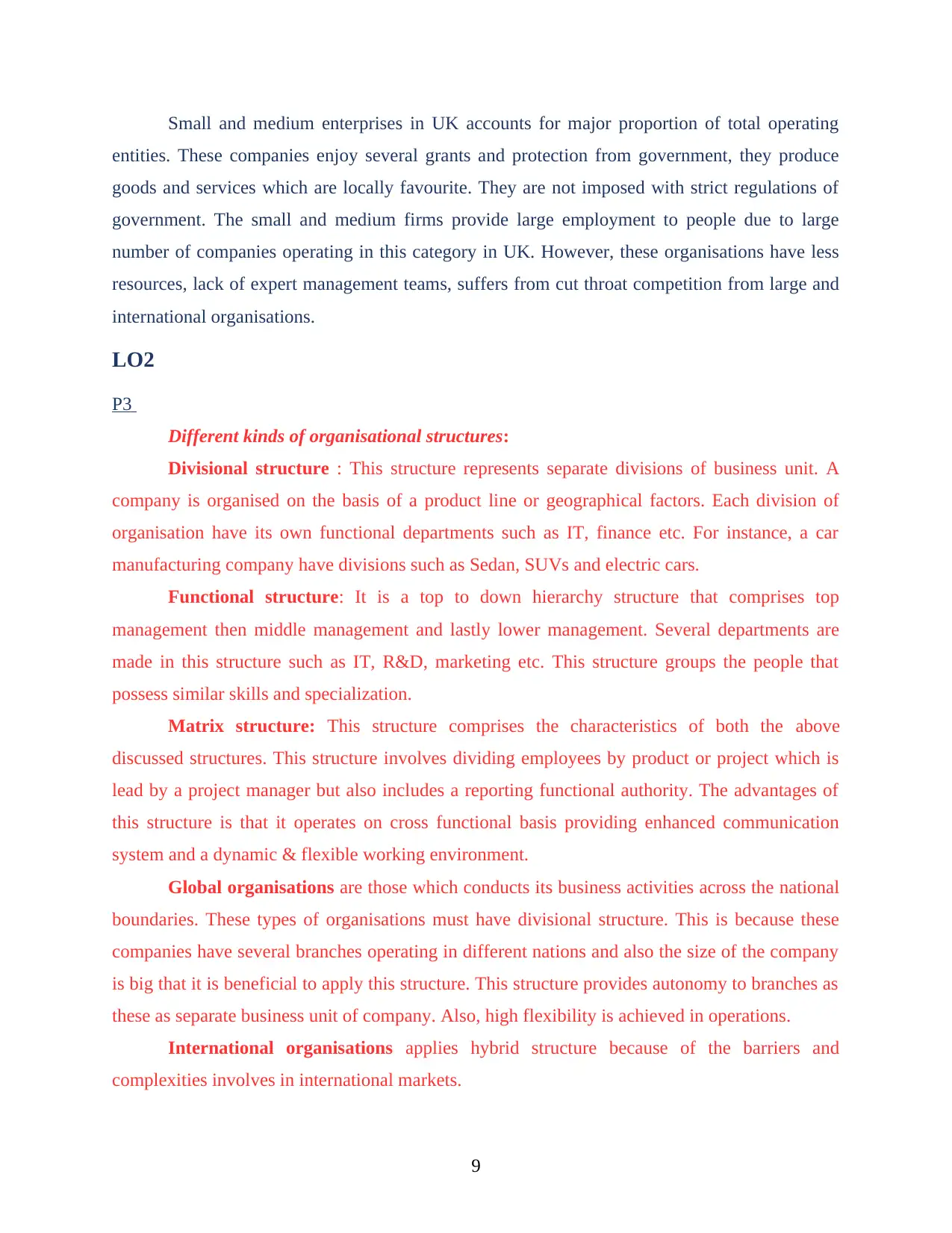
Small and medium enterprises in UK accounts for major proportion of total operating
entities. These companies enjoy several grants and protection from government, they produce
goods and services which are locally favourite. They are not imposed with strict regulations of
government. The small and medium firms provide large employment to people due to large
number of companies operating in this category in UK. However, these organisations have less
resources, lack of expert management teams, suffers from cut throat competition from large and
international organisations.
LO2
P3
Different kinds of organisational structures:
Divisional structure : This structure represents separate divisions of business unit. A
company is organised on the basis of a product line or geographical factors. Each division of
organisation have its own functional departments such as IT, finance etc. For instance, a car
manufacturing company have divisions such as Sedan, SUVs and electric cars.
Functional structure: It is a top to down hierarchy structure that comprises top
management then middle management and lastly lower management. Several departments are
made in this structure such as IT, R&D, marketing etc. This structure groups the people that
possess similar skills and specialization.
Matrix structure: This structure comprises the characteristics of both the above
discussed structures. This structure involves dividing employees by product or project which is
lead by a project manager but also includes a reporting functional authority. The advantages of
this structure is that it operates on cross functional basis providing enhanced communication
system and a dynamic & flexible working environment.
Global organisations are those which conducts its business activities across the national
boundaries. These types of organisations must have divisional structure. This is because these
companies have several branches operating in different nations and also the size of the company
is big that it is beneficial to apply this structure. This structure provides autonomy to branches as
these as separate business unit of company. Also, high flexibility is achieved in operations.
International organisations applies hybrid structure because of the barriers and
complexities involves in international markets.
9
entities. These companies enjoy several grants and protection from government, they produce
goods and services which are locally favourite. They are not imposed with strict regulations of
government. The small and medium firms provide large employment to people due to large
number of companies operating in this category in UK. However, these organisations have less
resources, lack of expert management teams, suffers from cut throat competition from large and
international organisations.
LO2
P3
Different kinds of organisational structures:
Divisional structure : This structure represents separate divisions of business unit. A
company is organised on the basis of a product line or geographical factors. Each division of
organisation have its own functional departments such as IT, finance etc. For instance, a car
manufacturing company have divisions such as Sedan, SUVs and electric cars.
Functional structure: It is a top to down hierarchy structure that comprises top
management then middle management and lastly lower management. Several departments are
made in this structure such as IT, R&D, marketing etc. This structure groups the people that
possess similar skills and specialization.
Matrix structure: This structure comprises the characteristics of both the above
discussed structures. This structure involves dividing employees by product or project which is
lead by a project manager but also includes a reporting functional authority. The advantages of
this structure is that it operates on cross functional basis providing enhanced communication
system and a dynamic & flexible working environment.
Global organisations are those which conducts its business activities across the national
boundaries. These types of organisations must have divisional structure. This is because these
companies have several branches operating in different nations and also the size of the company
is big that it is beneficial to apply this structure. This structure provides autonomy to branches as
these as separate business unit of company. Also, high flexibility is achieved in operations.
International organisations applies hybrid structure because of the barriers and
complexities involves in international markets.
9
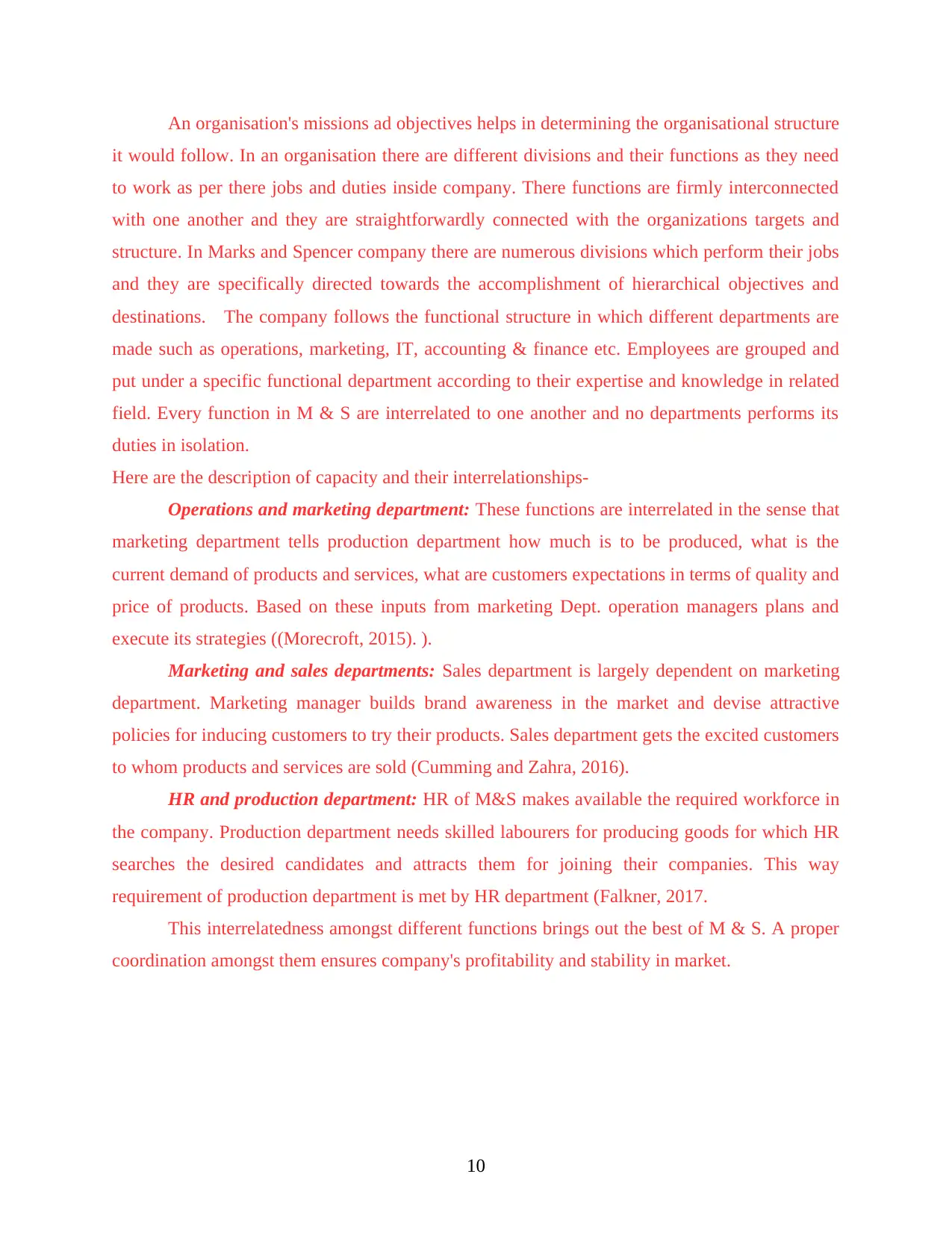
An organisation's missions ad objectives helps in determining the organisational structure
it would follow. In an organisation there are different divisions and their functions as they need
to work as per there jobs and duties inside company. There functions are firmly interconnected
with one another and they are straightforwardly connected with the organizations targets and
structure. In Marks and Spencer company there are numerous divisions which perform their jobs
and they are specifically directed towards the accomplishment of hierarchical objectives and
destinations. The company follows the functional structure in which different departments are
made such as operations, marketing, IT, accounting & finance etc. Employees are grouped and
put under a specific functional department according to their expertise and knowledge in related
field. Every function in M & S are interrelated to one another and no departments performs its
duties in isolation.
Here are the description of capacity and their interrelationships-
Operations and marketing department: These functions are interrelated in the sense that
marketing department tells production department how much is to be produced, what is the
current demand of products and services, what are customers expectations in terms of quality and
price of products. Based on these inputs from marketing Dept. operation managers plans and
execute its strategies ((Morecroft, 2015). ).
Marketing and sales departments: Sales department is largely dependent on marketing
department. Marketing manager builds brand awareness in the market and devise attractive
policies for inducing customers to try their products. Sales department gets the excited customers
to whom products and services are sold (Cumming and Zahra, 2016).
HR and production department: HR of M&S makes available the required workforce in
the company. Production department needs skilled labourers for producing goods for which HR
searches the desired candidates and attracts them for joining their companies. This way
requirement of production department is met by HR department (Falkner, 2017.
This interrelatedness amongst different functions brings out the best of M & S. A proper
coordination amongst them ensures company's profitability and stability in market.
10
it would follow. In an organisation there are different divisions and their functions as they need
to work as per there jobs and duties inside company. There functions are firmly interconnected
with one another and they are straightforwardly connected with the organizations targets and
structure. In Marks and Spencer company there are numerous divisions which perform their jobs
and they are specifically directed towards the accomplishment of hierarchical objectives and
destinations. The company follows the functional structure in which different departments are
made such as operations, marketing, IT, accounting & finance etc. Employees are grouped and
put under a specific functional department according to their expertise and knowledge in related
field. Every function in M & S are interrelated to one another and no departments performs its
duties in isolation.
Here are the description of capacity and their interrelationships-
Operations and marketing department: These functions are interrelated in the sense that
marketing department tells production department how much is to be produced, what is the
current demand of products and services, what are customers expectations in terms of quality and
price of products. Based on these inputs from marketing Dept. operation managers plans and
execute its strategies ((Morecroft, 2015). ).
Marketing and sales departments: Sales department is largely dependent on marketing
department. Marketing manager builds brand awareness in the market and devise attractive
policies for inducing customers to try their products. Sales department gets the excited customers
to whom products and services are sold (Cumming and Zahra, 2016).
HR and production department: HR of M&S makes available the required workforce in
the company. Production department needs skilled labourers for producing goods for which HR
searches the desired candidates and attracts them for joining their companies. This way
requirement of production department is met by HR department (Falkner, 2017.
This interrelatedness amongst different functions brings out the best of M & S. A proper
coordination amongst them ensures company's profitability and stability in market.
10
⊘ This is a preview!⊘
Do you want full access?
Subscribe today to unlock all pages.

Trusted by 1+ million students worldwide
1 out of 20
Related Documents
Your All-in-One AI-Powered Toolkit for Academic Success.
+13062052269
info@desklib.com
Available 24*7 on WhatsApp / Email
![[object Object]](/_next/static/media/star-bottom.7253800d.svg)
Unlock your academic potential
Copyright © 2020–2025 A2Z Services. All Rights Reserved. Developed and managed by ZUCOL.





